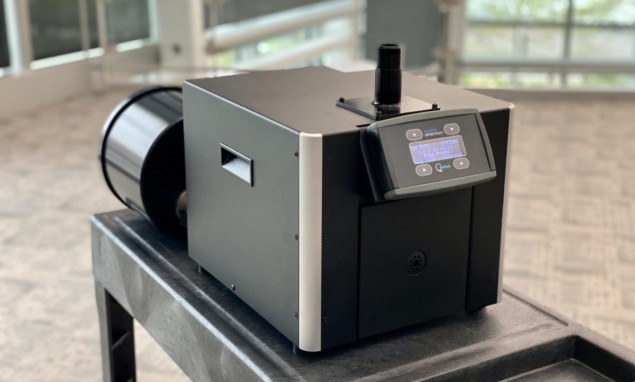
A device claimed to detect the virus that causes COVID-19 in ambient air within 2–3 min has been successfully tested at two universities in the US. It was developed by the company Smiths Detection, which says that the test has a sensitivity equivalent to PCR testing. The test is now commercially available in the US and is being prepared for a global rollout.
The ideal way of testing for the SARS-CoV-2 virus is using the reverse transcriptase polymerase chain reaction (RT-PCR or often just PCR). This involves taking a sample from the patient, using one enzyme to transform the viral RNA into DNA before thermally separating that DNA into single strands. The complementary fragment is then added to a sequence of the helix found only in the virus, recreating a short section of double helix if and only if the virus is present. Finally, this is amplified to produce a positive result.
Although a well-established technique, PCR can take days to produce a result – days during which an infected patient may infect others. Tests that can analyse samples more rapidly tend to be less sensitive. Moreover, an asymptomatic patient may have no reason to provide a sample for testing. A product that could rapidly detect SARS-CoV-2 in the ambient air would therefore be highly valuable, and several academic research groups and companies are working towards that aim.
Smiths Detection developed their BioFlash Biological Identifier over 10 years ago to detect toxins such as ricin and pathogens like the anthrax bacterium. The device is currently used by the US government and commercial companies such as couriers.
Jellyfish genes
“Previously, our focus was on biothreats that were intentionally released,” explains Andrew Flannery, one of the company’s chief scientists. The system uses a technology called CANARY developed by researchers at Massachusetts Institute of Technology. Genetically engineered immune cells bind to one specific target such as a toxin or pathogen. When they do so, they begin to emit light: “When CANARY technology was originally developed, [the MIT researchers] basically cloned out the same genes that jellyfish use to be bioluminescent,” explains Flannery. In addition to BioFlash, Smiths Detection has used the CANARY platform in sensors to detect pathogens in food and to monitor the health of plants in agriculture.
The company realized that, if the BioFlash could detect SARS-CoV-2, it could defend not just against malicious threats but against unintentional ones posed by infected individuals too. “We had to identify antibodies that would bind specifically to SARS-CoV-2,” explains Flannery, “We had to screen several antibodies that would be resistant to any mutations that might happen and lead to false negatives to make sure we picked the right one. That way we can be sure that, even if there are variants that pop up, we will still be able to detect them.”
The company now reports two real-world tests: one at the University of Maryland, Baltimore and the other at the University of Oregon. The first Maryland result detected the presence of SARS-Cov-2 in a locker room, leading to three positive diagnoses among members of a sports team, whereas the second confirmed its absence in a research facility in which a member had tested positive for COVID-19. The Oregon experiment detected the virus exhaled by quarantined patients with confirmed COVID-19.
Confirming virus mitigation
“Ultimately, we want to be part of the overall covid mitigation strategy,” says Warren Mino, the managing director of biotechnology at Smiths; “Having a device that will confirm that their mitigation strategies are working, I think, helps people to know that what they’re doing is effective in keeping people safe – especially as we try to get back to our daily, regular lives.”

Nanophotonic biosensor tests for COVID-19, hot topics in medical physics
Laura Lechuga of the Catalan Institute of Nanoscience and Nanotechnology, whose group has developed a spectroscopic liquid biosensor for SARS-Cov-2, is cautiously impressed: “As far as I know, there is no solution for on-site detection of SARS-CoV-2 in air (or aerosols) commercially available. There are many developments on-going at academic research and industrial level, but no one is close to commercialization. So, this Smiths device could become the first detector and could be [in massive demand],” she says. She cautions, however, that “the detection of any pathogen in air is really complex, due to the influence of the way the air sampling is performed, the specificity (to avoid cross-reactivity with other biomolecules and chemical molecules in the air) and, more importantly, the sensitivity level, as normally pathogens are present in the aerosols at a very low level”.
Lechuga adds that there is not currently enough public information available for her to evaluate the device. Smiths Detection told Physics World that the relevant proprietary information is provided to prospective customers.



